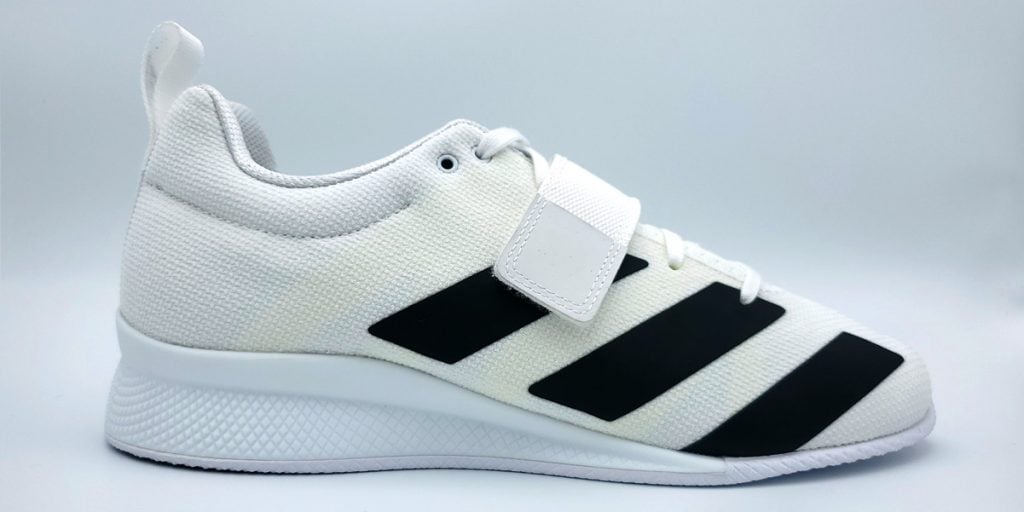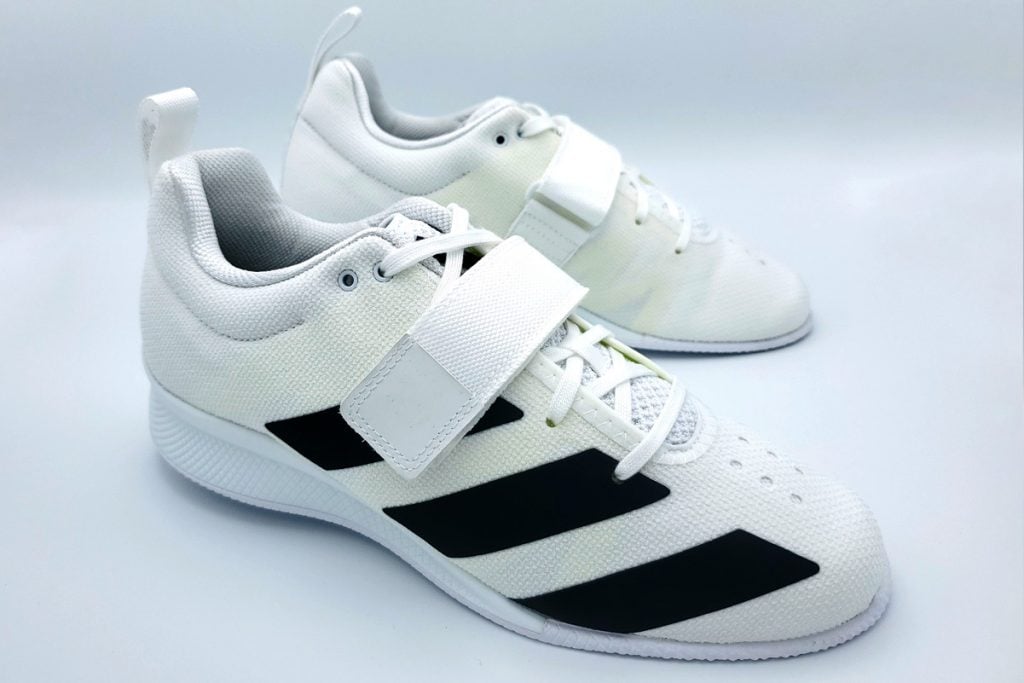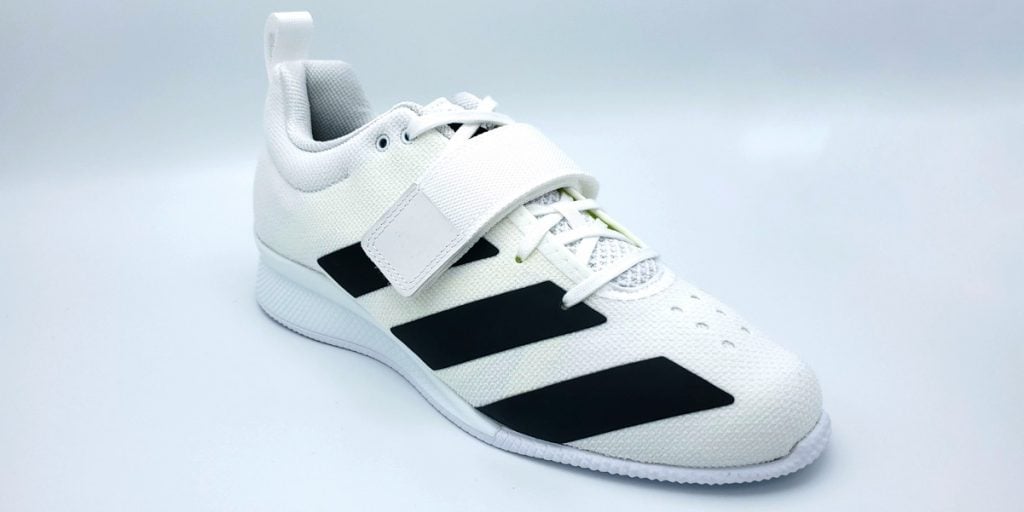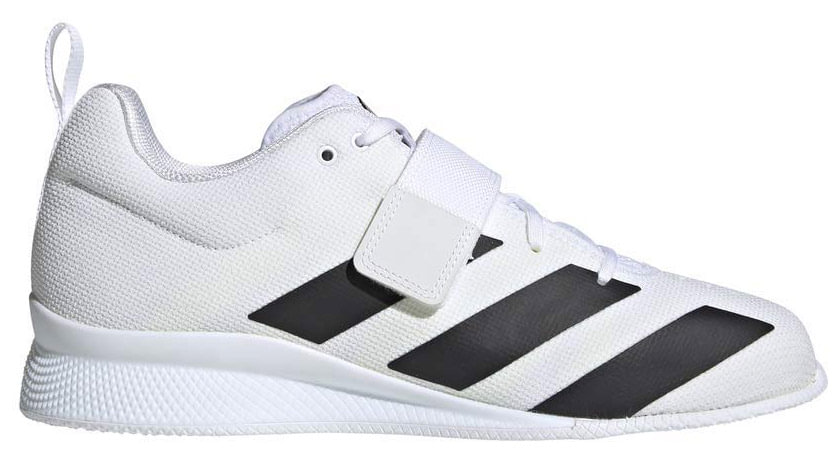The Adipower 2 weightlifting shoe is the hotly anticipated successor to the tried and true Adipowers. We’ve picked up a pair to see how they perform while weightlifting, powerlifting, and cross training.
| Specs | ||
weight 460g / 16.2 oz | height 20.1mm / 0.79in | wedge solid TPU |
Overall Design
The overall aesthetic of the Adipower 2 is super sleek. It’s more minimalist than most weightlifting shoes, with a focus on bold edges and crisp textures evocative of barbell knurling.
The shoe is available in black, white, and blue.
 |  |  |
| Check Price | Check Price | Check Price |
We copped a pair of the white shoes for review. We have gotten a few dirt smudges every few sessions, but they’re pretty easy to wipe off. If you’re concerned about dinginess, we’d recommend the black or blue pair.
Update: After a few months of use, the white shoes are still looking pretty pristine. They’ve been taken care of and only worn inside the gym, which has made it pretty easy to keep them clean.
If you’re not super tidy or don’t have a gym bag to keep them in, we would still recommend the black or blue shoe.

The Upper
The Adipowder 2’s woven textile upper is sturdy yet pliable. By just flexing and tugging at it, it’s clear that the material is built to last.
And the weave of the material has a really satisfyingly tactile finish. It’s got some grip to it, but it’s not harsh on the hands by any means.
On the outside of the upper, three strips of lamination form the Adidas stripes (which look especially sleek on the white shoe). We were concerned about how these might hold up over time, but up close, it’s easy to see how tightly they’re bonded. With almost no lip, it would take significant effort to peel them off.

Overall, we’re big fans of the upper’s materials and design language.
And we’re just as happy with the functionality.
The shoelaces feed through 5 eyelets on each side, stopping just short of the toes. There’s a 6th eyelet at the top of either side for lace locking, if you’re into tying your shoes that way.
A hooked velcro strap covers the 3rd and 4th eyelets, just over the bridge of the foot. The outer nylon material feels really sturdy, and strap is positioned such that it won’t drag even when tightened all the way.

It all comes together to make a shoe that fits really well.
The lacing and strap positioning feel great, and the woven textile upper is flexible enough that you can really cinch down for a snug fit—without getting uncomfortable.
That tighter fit really helps to support the outside of the foot when lifting.
Speaking of support…
The Sole
The Adipower 2 heel height is 0.79 inches (20.1 millimeters), with a sturdy TPU wedge midsole.
Looking at the side of the shoe, you can see that the wedge goes all the way up to roughly the ball of the foot.

This provides solid support for the heel and midfoot. From the ball of the foot forward, the Adipower 2 has a little more flex than most weightlifting shoes.

The outsole is a really grippy, rubbery material. To boost its grip, the forefoot and heel feature a diamond texture really similar to barbell knurling. It’s really satisfying to the touch.

We were initially worried that this knurling texture might wear down after a while. However, after a couple months of heavy workouts in these shoes, the outsole shows little sign of wearing down.
Good For…
- First-Timers
If you’ve never owned a pair of weightlifting shoes before, these are a great place to start.
Most sneakers, cross trainers, and the like are flexible and cushioned. Switching from something so pliable to a stiff weightlifting shoe can be jarring.
The Adipower 2 hits the sweet spot. It’s as solid and supportive as you need for weightlifting and powerlifting, but just flexible enough to still allow some cross training.
- CrossFit
If you’re looking for weightlifting shoes for CrossFit, the Adipower 2 is a great option.
If your WOD (workout of the day) involves Olympic lifts, it’s best to use proper weightlifting shoes. The catch is that most weightlifting shoes are too stiff for most agility exercises, and you won’t have the time to keep swapping shoes.
Enter the Adipower 2. The flexibility toward the front of the shoe allows for more agility than most weightlifting shoes. These will work fine for box jumps, rope skipping, lunges, burpees, and more.
The only caveat is running. If your WOD involves jogging or sprinting, you’re going to want to switch to your cross trainers.
- Style
It all comes down to preference, but a lot of weightlifting shoes look… bad. Not these ones.
These are much more modern and minimalist than most weightlifting shoes. While a lot of other options look chunky and noisy, these look more like a sleek pair of sneakers you’d see on the street.
If you’re looking for a stylish weightlifting shoe, you can’t go wrong with the Adipower 2.

Why Use Weightlifting Shoes?
If you’re a pro, skip down to the review. For those who haven’t used weightlifting shoes before, here’s a quick rundown.
Weightlifting shoes are designed to improve three things: biomechanics, responsiveness, and stability.
- Biomechanics
Lifts with squatting motions, such as font and back squats, cleans, and snatches, are often limited by ankle mobility—specifically, ankle dorsiflexion (lifting the foot).
Since weightlifting shoes have a raised heel, less dorsiflexion is needed to reach the very bottom of a squat.
Even for people with good ankle range of motion, weightlifting shoes make deep squats feel much more natural.
- Responsiveness
Joggers, runners, sneakers—whatever you call them, running shoes are designed to compress and absorb impact.
When you’re weightlifting, these kinds of shoes can absorb precious energy needed to launch the weight upward. There’s a moment during that initial thrust where these shoes squish down, siphoning your momentum.
Weightlifting shoes, on the other hand, typically feature midsoles made of wood or TPU (a sturdy plastic). They don’t compress, so much less energy is wasted during the lift.
- Stability
When you’re lifting on your feet, you want to be as stable as possible. This is especially true for Olympic lifts, like squats and cleans.
Weightlifting shoes are designed to maximize stability. They help prevent rolling and slipping during the lift.
To do this, they typically feature large and flat outsoles, with more surface area contacting the ground. And instead of a running tread, the outsole is usually made with a shallower texture to grip the platform.

